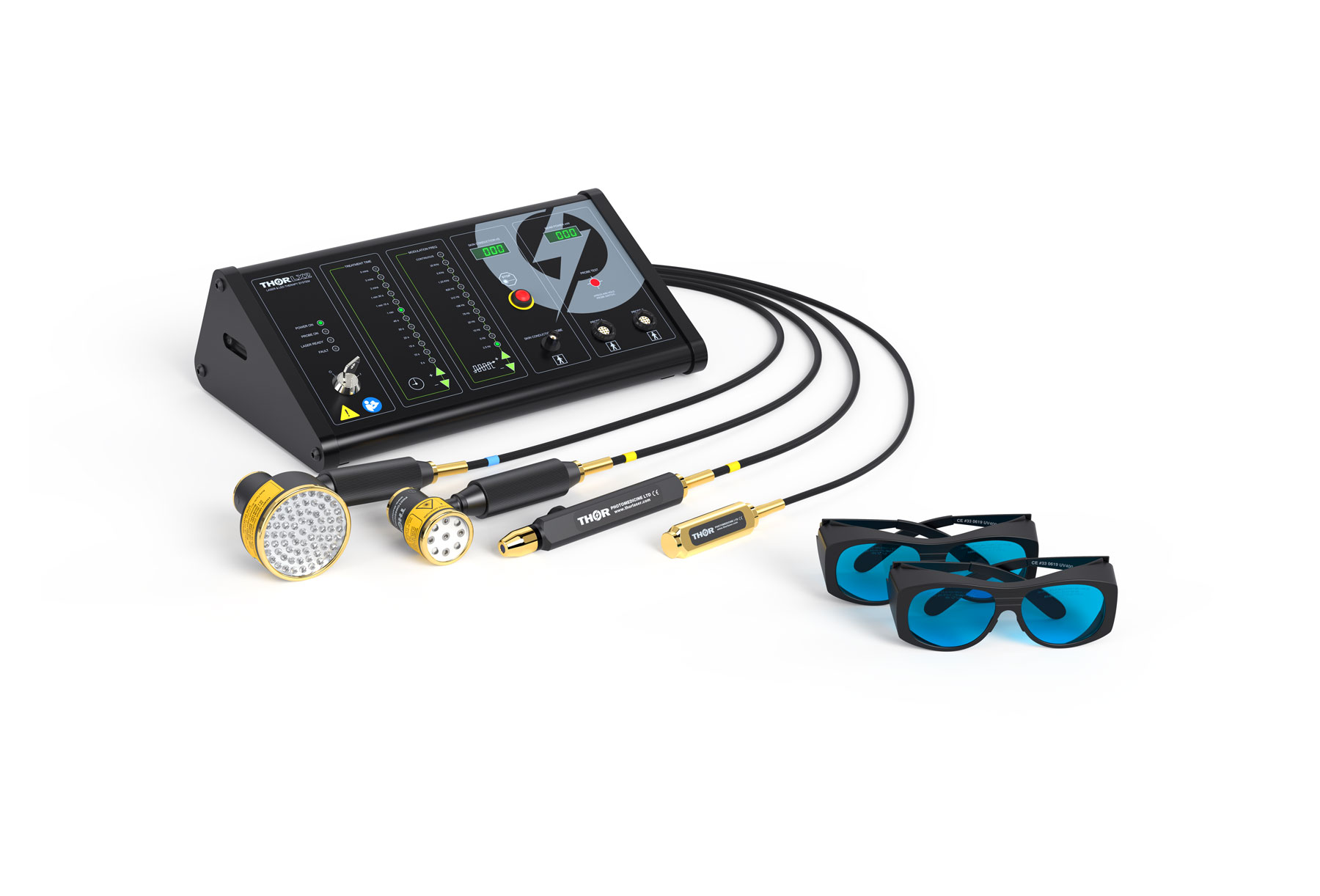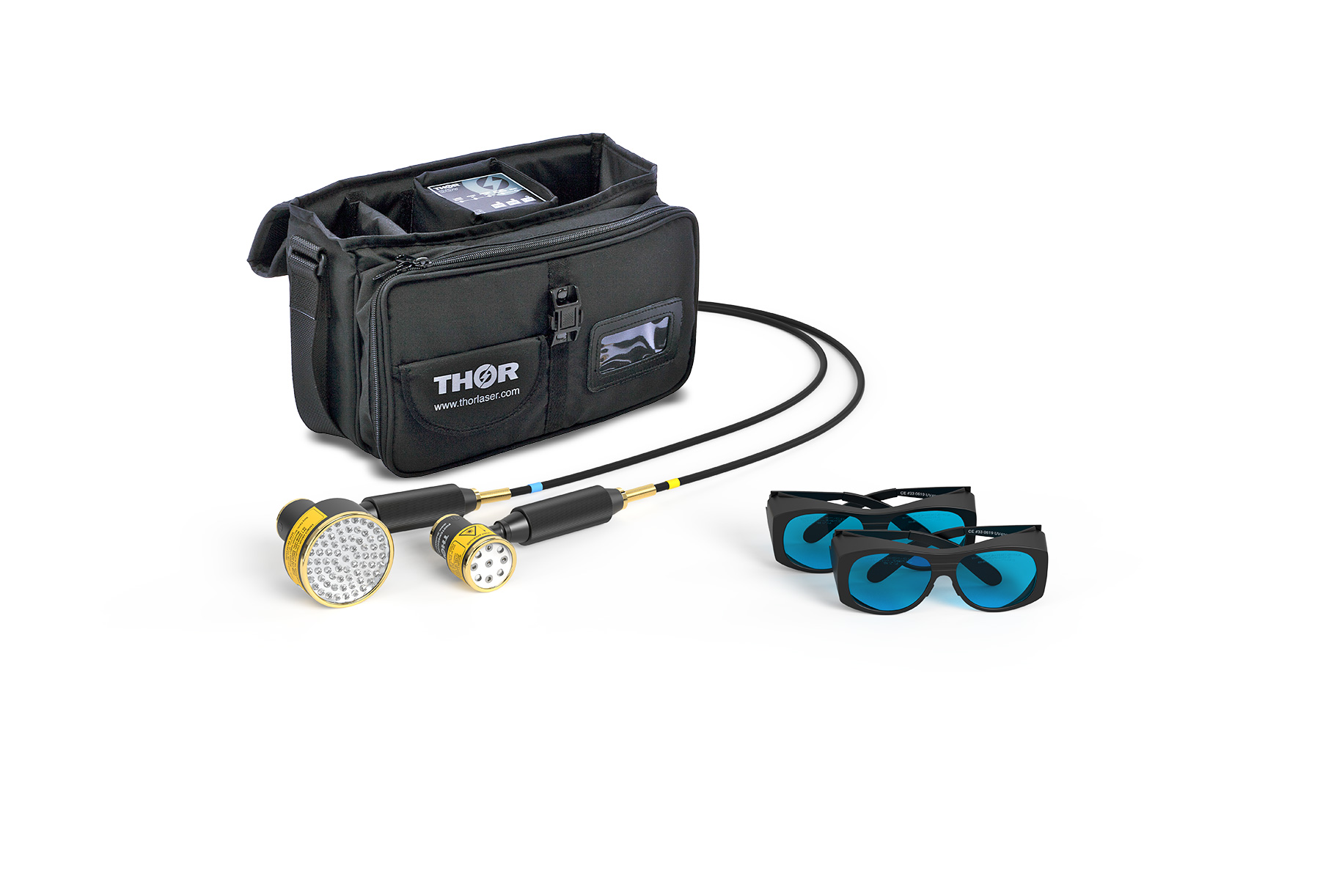
A Drug Free Alternative for Vets
Photobiomodulation (PBM Therapy) previously known as Low Level Laser Therapy (LLLT) can treat:
- Degenerative disc disease
- Corneal diseases
- Head trauma
- Muscle, tendon & ligament injuries
- Pain management for trauma & post surgical wounds
- Inflammation & swelling
- Wound healing including degloving injuries & more
What is it?
Laser and LED beams of light can stimulate the cells in the body that repair tissue, reduce inflammation and transmit pain.
How PBM works
Certain wavelengths of light can stimulate or inhibit cellular function according to it's intensity and the time applied.
Lasers and LED's produce intense beams of light at specific wavelengths. When the right wavelength at the right intensity is used at the correct anatomical location for the right amount of time you can stimulate repair, resolve inflammation and reduce pain.
One of the primary mechanisms is the effect of light on cytochrome c oxidase and the consequently the unbinding of nitric oxide and release of ATP leading to improved cellular function. For anti-inflammatory effects we have found a measurable reduction in PGE2, TNF Alpha and IL-6 in the synovia surrounding damaged tendons and for analgesia high intensity lasers over nerve supply can inhibit fast axonal flow.
In addition, high intensity single point lasers can release trigger points and treat acupuncture points instead of needles.
Once you understand these mechanisms and their subsequent physiological effects PBM becomes a powerful tool. We hope you use your laser extensively and create great value for patients and your practice. PBM improve healing and are a drug free analgesic.
View our training dates
Register now for early bird and group discounts.
3B or Class IV Lasers? What's the difference?
Class IV lasers are stronger than 3B but they do not work as well because they can over treat tissue. Just like any medicine an overdose can be a bad thing.
Class IV beams need to be defocused so that they do not cut tissue, and so they work in the same fashion as 3B lasers, but even so the beams are still a bit too strong and do not work so well. Scientific evidence confirms that lower intensity is more effective for inflammation and healing. High intensity is however good for analgesia so THOR have both high and low intensity lasers / LEDs. Read more here 3B vs Class IV Lasers
Download 'Veterinarian Intro and Research (PDF)' Includes 24 clinical trial abstracts
Prices from US$16,000 to US$40,000 (£12,495–£31,995 + VAT)

LX2 Table Top system includes:
- LX2 table top control unit
- Large healing / anti-inflammatory 69 LED cluster
- Analgesic 810nm 1Watt laser cluster (5 x 200mW)
- Trigger Point 810nm 200mW laser
- Point locator
- 6 year conditional warranty
- Access to the THOR treatment library
- 2 x Laser safety glasses

DDv Portable system includes:
- DDV Portable control unit
- Large healing / anti-inflammatory 69 LED cluster
- Analgesic 810nm 1Watt laser cluster (5 x 200mW)
- 5 year conditional warranty
- Access to the THOR treatment library
- 2 x Laser safety glasses
Contact us about our 'Large Animal', 'Companion Pet' and 'Feline and exotic' package options.
When did you start using PBM?
Why did you choose THOR?
How effective is PBM?
THOR is not a Class IV laser, does that affect it's efficacy?
What conditions do you use PBM for?
How has PBM changed your practice?
We make it simple
- Online treatment library:
Shows you which probe, what settings and where to treat. - Online tech and treatment support:
If you cant find a treatment protocol you need, we will write it for you. - Hands on training:
We run 24 training courses in the USA, 24 in the UK and 6 in Australia every year.
Product information and purchase enquiry
Sorry for the long form.
We are a global company and our computer needs to know who to direct your enquiry to.
* Mandatory field - this automatically directs your enquiry to the correct department
THOR Photobiomodulation Newsletter (See previous edition)
Please add me to the THOR training, research and conference Newsletter.
Case Studies

Chronic Osteoarthritis
Trunces - 20 year old Short Hair
History - 20 year old domestic short hair neutered male cat with hind end stiffness of several years.
Diagnosis - Osteoarthritis of both stifle joints as well as spondylosis of the lumbar spine.
Previous Treatment - Occasional use of NSAIDs resulted in some improvement in mobility but the patient would no longer climb stairs or jump onto furniture. The owner believed that his quality of life was acceptable, but was hoping for a means to improve comfort.
Laser Therapy - Laser therapy was initiated with LED cluster over the stifles, lumbar spine, sacrum and adjacent lymphatics.
Results - The owner reported improved alertness after the initial session with improved mobility noted after the second treatment. After five laser treatments the patient climbed stairs, became more active and jumped onto low pieces of furniture. Tail activity returned.
The patient is well controlled with every third week sessions.

Degenerative Disc Disease
BAILEY - 3 year old Dachshund Cross
History - 3 year old spay female Dachshund cross with acute onset of hind end paralysis of 48 hours duration. Deep pain reflex was intact but there was no voluntary movement of hind legs. Patient was depressed and anorectic.
Diagnosis - Degenerative disc disease with collapsed disc space and suspected disc herniation at lumbar spine L2-L3.
Previous Treatment - NSAID was administered by the previous veterinarian with little or no response.
Laser Therapy - Therapy was initiated with LED cluster and laser probe over thoracolumbar spine.
Results - Within several hours after first treatment the patient's appetite returned and she was more engaged. After the second treatment five days later, the patient was bright and had a withdrawal reflex in her left hind leg. Deep pain reflexes remained intact. After the third treatment the patient supported her weight and walked on three legs. She was comfortable and able to urinate on her own. Three weeks after the initial laser treatment (4 treatments total) the patient ran with a mild proprioceptive deficit on the right hind leg.
Two months after the initial episode, the patient is clinically normal.

Soft Tissue Injury
MOLLY - 3 year old Welsh Corgi
History - 3 year old spay female Welsh Corgi was presented with a one day duration of extreme pain in the right front leg.
Diagnosis - Palpation without sedation was unattainable. Radiographs were negative for osseous lesions. Pain appeared to be most significant in the area of the elbow.
Previous Treatment - The apparent soft tissue injury was treated with NSAIDs. Within twenty four hours the pet became severely ill with hemorrhagic enteritis and gastritis secondary to NSAID use. After supportive therapy the gastrointestinal signs subsided but the front leg pain was present and intense.
Laser Therapy - Laser therapy was initiated using the laser probe over the elbow (obvious point of discomfort) and the LED hand piece over adjacent lymphatics. The laser probe was also used to achieve a temporary nerve block.
Results - After the second laser treatment a limp remained present but the pain was considerably less. After the fourth treatment the patient was sixty to seventy percent weight bearing. At the sixth treatment, the owner stated the patient was "ninety five percent" improved and elected to terminate the treatments at that time.
The patient is pain free six months later.

Chronic Osteoarthritis
AL - 7 year old Irish Setter
History - 7 year old neutered male Irish Setter with a history of intermittent left front leg lameness of three years.
Diagnosis - Osteoarthritis of the left carpus and interphalangeal joints of the second and third digit.
Previous Treatment - Initially responded to polyglycosated aminoglycans and NSAIDs. After 24 months the lameness became less responsive to the medications and the patient's demeanor became lackadaisical. Surgery consult offered carpal fusion but was determined too aggressive for the current condition.
Laser Therapy - Laser therapy was initiated using the LED cluster to regional lymphatics, and both the LED and laser probe over the affected sites.
Results - Within three treatments the patient's demeanor improved considerably. He became more active and engaged. After the fourth treatment the lameness appeared to be improving and subsequently disappeared after the seventh session.
Currently he remains pain free and active with laser therapy every 3rd or 4th week.
Economic Benefits of Offering Low Level Laser / Photobiomodulation Therapy
Investing in a THOR Photomedicine PBM system for your practice will not only enhance your existing treatment regimes but will also allow you to offer long term, drug-free side-effect free pain relief when surgery is not applicable or desirable.
Integration of Photobiomodulation in a Veterinary Practice
Low level laser therapy can be incorporated into a practice in a number of ways:
- As an additional pre and post-surgical treatment.
- A new and drug free treatment alternative for osteoarthritis, degenerative disc disease, and other musculoskeletal conditions
- Chronic and acute pain management
Financial Return
Low level laser therapy treatment can be added to surgical protocols as an ancillary treatment for non-cancerous lump removals, orthopedic surgeries, foreign body surgeries and wounds. Adding PBM to the protocols will improve the speed and quality of tissue repair and reduce inflammation and pain.
The treatment will increase revenue and does not require veterinarians to convince clients to switch treatments.
Overall Financial Benefits
Financially, the PBM treatments will provide a regular stream of income. A typical protocol is approximately 6 visits within the first 4 weeks and then maintenance treatments every 3 to 4 weeks or until resolution.
The frequency of patients’ visits will increase the probability of further product purchases, such as heartworm and flea preventatives, ear cleaning products,and dental products. Additionally, closer monitoring of a patient’s condition will lead to earlier diagnosis of other potential medical issues.
The cost of switching from pharmaceuticals to PBM treatment is minimal. The margins from drug sales are constantly being squeezed by pressure from internet pharmacies and alternative sources. The loss of income by reducing the need for frequent chemistry profiles will be far outweighed by the continual visits for treatment.
In summary, a vet practice which includes THOR PBM into their business can profit in a number of ways. The most obvious one would be more positive treatments.
Want to offer this service to your own patients?
 Featured Testimonials
Featured Testimonials





Featured Testimonials
"One of the biggest decisions when purchasing a laser is Class III or Class IV. We have another company's Class IV laser at work and I have a Thor laser for my mobile acupuncture practice. After using both, I have found that the Thor (Class IIIb laser and LED combo) is more gentle, more effective, and most importantly safe to use under circumstances where laser is contraindicated, such as active bleeding or over the eye.
I use photobiomodulation in both acupuncture and veterinary emergency settings. The LED promotes healing and reduces inflammation, while the laser probe is used primarily at nerve roots and trigger points to relieve pain. Laser/LED combination therapy provides pain relief and has a calming effect prior to acupuncture treatment. I have found that patients tolerate needles much better after PBM, and the effect of treatment is enhanced and prolonged when combined with laser therapy.
In the emergency setting, the LED cluster has been indispensable. I use it to promote healing, reduce inflammation and prevent infection after surgical repair of traumatic injury, to reduce swelling of joints, for any inflammatory condition involving the eye and many other applications. We recently used the LED to treat a severe snakebite wound, which significantly reduced swelling and tissue necrosis compared to similar injury without treatment. Without the LED cluster, we could not have applied laser therapy directly to the affected tissue due to severe venom-induced coagulopathy.
I highly recommend the Thor system for its quality, durability, portability and versatility. In my opinion, there is no better PBM unit available anywhere. Now that I have one, I can't imagine working without it."
Living Balance Veterinary Acupuncture
Denver, CO, USA
"After attending the Orlando CE meeting and all the learning that has followed I have come to the conclusion that Thor beats them all, on several levels.
The Orlando CE meeting was one of the best that I have ever attended. I learned a lot about a complex topic in an easier to understand and clinically relevant way. James Carroll is a fabulous, fun teacher and a humble genius in the area of PBM. After the meeting, I had a lot more questions.
Dr. Ron Hirschberg and Valerie Gause answered any question I had with science and the literature to back up their information.
The other companies can't hold a candle to your customer service. You have provided and defended the science behind your product. You have been professional in not bashing the competition, simply pointing out the flaws in their claims. You have helped me to navigate the marketing tricks and understand the difference between what happens in the laboratory and clinical setting.
Though I do believe other products have merit and the ways in which we use light therapy will change as we learn more, I feel comfortable that Thor's unit will not become obsolete in the near future because of the built in flexibility of the interchangeable heads and frequencies.
You are the only company (of the three I have been looking at) that has been able to demonstrate to me that should I purchase your unit, we will be set up for success because of the support and education you provide. Lots of companies promise support but none have demonstrated to me that their treatment protocols are more than trial and error. Dr. Hirschberg is getting better clinical results in less time because his protocols are based on the whole animal's physiology and the science behind PBM.
I can't thank you enough for the time and assistance you have provided me as I have gone through this intense process and learning curve."
Vale Park Animal Hospital
Valparaiso, IN, USA
"The use of THOR Lasers in our practice has brought a new dimension to the treatment of degenerative disc disease, chronic osteoarthritis and a multitude of other medical and surgical conditions in both canine and feline patients. Our client's acceptance and compliance has exceeded all expectations as they welcome the presence of an innovative and effective technology that reduces the dependency on traditional anti-inflammatory agents. The use of Thor lasers in our practice continues to expand as we discover additional uses almost daily."
Brockton Animal Hospital
Brockton, MA, USA
"It is a pleasure to recommend the THOR laser. I have been a client for two years. I purchased a THOR laser and it has been under extensive use. I find it superior to any other laser available for the type of therapy I employ. I certainly appreciate the support that you offer after the sale, this is oftentimes forgotten with others...Thanks."
H.L. Mitchell, DVM
HLM/ep
Bristow Veterinary Clinic, L.L.C.
"Guide Dogs for the Blind were over the moon with how well the laser worked on one of their retired dogs, which I treated in Boston Spa 3 years ago, and they wanted to know where I went to work next in case they needed my THOR again."
Rae, Bean & Partners Boroughbridge
BSAVA NE Secretary
"The Thor laser has been of great benefit in the treatment of pain. We primarily treat horses, dogs and cats with acupuncture. Several times there have been acupuncture points that these animals would not allow us to treat with needles. It is at these times that we have used the Thor laser. Before now, other lasers have not provided enough stimulation to treat the acupuncture points. The Thor laser does provide enough power and has been very effective in treating acupuncture points.
Locally, it has been very beneficial in treating myofascial pain that was resistant to acupuncture. Overall, this instrument has allowed me to take the care for my patients to a higher level. I would not want to practice without it."
El Cajon Valley Veterinary Hospital
CA, USA